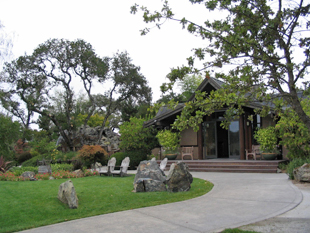

The McWilliams couldn't use their name for the winery since Gallo owned a similarly named winery in Australia. The letter from the Gallo attorney sent the family two alternative names: Arista won.
Arista Winery is Pinot Noir
Ground Zero
by
Michael Lasky
October 29, 2007
 hen your 36-acre estate in Russian River Valley is sandwiched between the vineyards of Williams Selyem to the south, Davis Bynum to the west and Rochioli to the north, then it can safely be considered PINOT NOIR GROUND ZERO. And that’s the felicitous happenstance that Mark McWilliams, proprietor of Arista Winery fell into when his family purchased this property on Westside Road from a former Proctor & Gamble executive in 2004.
hen your 36-acre estate in Russian River Valley is sandwiched between the vineyards of Williams Selyem to the south, Davis Bynum to the west and Rochioli to the north, then it can safely be considered PINOT NOIR GROUND ZERO. And that’s the felicitous happenstance that Mark McWilliams, proprietor of Arista Winery fell into when his family purchased this property on Westside Road from a former Proctor & Gamble executive in 2004.

Mark McWilliams holds one of the infant Pinot Noir vines on the Arista estate.
But, hey, that’s what his winery neighbors like Williams Selyem and Rochioli had to do – there is only so much of their coveted RRV Pinot available. Right now as Arista waits for its recently planted estate vines to mature, they source their grapes from nearby vineyards as well as some from another great Pinot Noir growing area - Anderson Valley.
Going Forward Pre-Sideways
“Fortunately we locked in our contracts before the movie Sideways. After that movie came out, it was impossible to find quality Pinot Noir fruit at a reasonable price. We lucked out with good timing,” McWilliams notes with a smile.“We are site-focused on all our wines. Terroir should appear in the bottle and the wine glass. Otherwise, there is no distinction from all the other wines out there, he says firmly. “I use Rochioli as the model on how to plant on a micro block scale, down to the row orientation of the vines.”
Head winemaker Leslie Sisneros pinpoints terroir more minutely, sometimes meticulously picking only the grapes from particular blocks of contracted

Arista winemaker Leslie Sisneros is looking forward to creating Pinot from the estate grapevines once they mature.
“Blending is the fun part of winemaking. It is the jigsaw puzzle, trying by trial and error to make all the parts fit exactly right. But it is a long process to get to the final right blend. Consider the variables: the grapes from various vineyards, the wide choice of barrels – by age and type of wood – and the percentages of each. It takes months to get it right,” she says.
“For example, our Longbow Russian River Pinot combines the toast of the barrels as well as the taste of the clonal mix and the vineyards from which they were grown.”
Demonstrating the wide variance of terroir, Mark McWilliams points out that two of Arista’s single vineyard Pinots, Mononi Vineyard and Toboni Vineyard [he is not making these names up] are grown from similar clones in vineyards less than a mile apart. “Yet each displays completely different characteristics in the bottle.”
(Toboni Vineyard is divided into multiple blocks which are planted to Dijon 115, 667, and 777, as well as Pommard clone 5, while Mononi Vineyard was planted to Dijon Clones 113 and 115.)

The McWilliams have enhanced the existing Japanese garden by the winery, which has views of the new vineyards in the distance.
Leslie continues: “I am for complexity without losing the grape’s delicacy. I don’t want to overshadow it by dominant wood flavors so the barrels used and the time the juice is in the barrels is utmost in my mind.”
Winemaking in the End is a Balancing Act
When asked about the trend toward high alcohol wines, Leslie explains, “As alcohol goes up, so does viscosity and mouth feel and Americans love that and buy that. Naturally, wineries cater to this selling point with long hang times, high sugars and lower acid. So, near to harvest, we check numerous times for acids to drop and sugars to balance. Sometimes we have to pick multiple vineyards the same day and with limited crush facilities that can be a nightmare.”Not that she goes out of her way to pull in high alcohol wines but when you are dealing with cool climate grapes, longer hang times are the rule, not the exception. Arista’s Pinots average about 14.2 percent alcohol but the sugar/acid balance is so precisely in check that the alcohol level is not an issue. [Read Michael Lasky’s reviews of Arista Winery Pinot Noirs to get a better sense of how balance pays off.]
 Mark adds:” Everyone talks about clones but rootstocks and soil are ultimately more important than clonal selection. Let’s face it: rootstocks are the foundation of any wine.”
Mark adds:” Everyone talks about clones but rootstocks and soil are ultimately more important than clonal selection. Let’s face it: rootstocks are the foundation of any wine.”
Arista’s estate vineyards, now in their infancy, reflect this philosophy. This fall, the baby vines will be cut back and no significant fruit will come forth for three years. Until then, the winery will continue to source fruit from neighboring vineyards - and probably even after estate fruit becomes available.
And while they impatiently wait for the first estate harvest, Mark has a more immediate harvest with the impending birth of his first child with wife Jennifer. The small family winery is slowly growing.
Photos © Michael Lasky










 READER FEEDBACK: To post your comments on this story,
READER FEEDBACK: To post your comments on this story,





